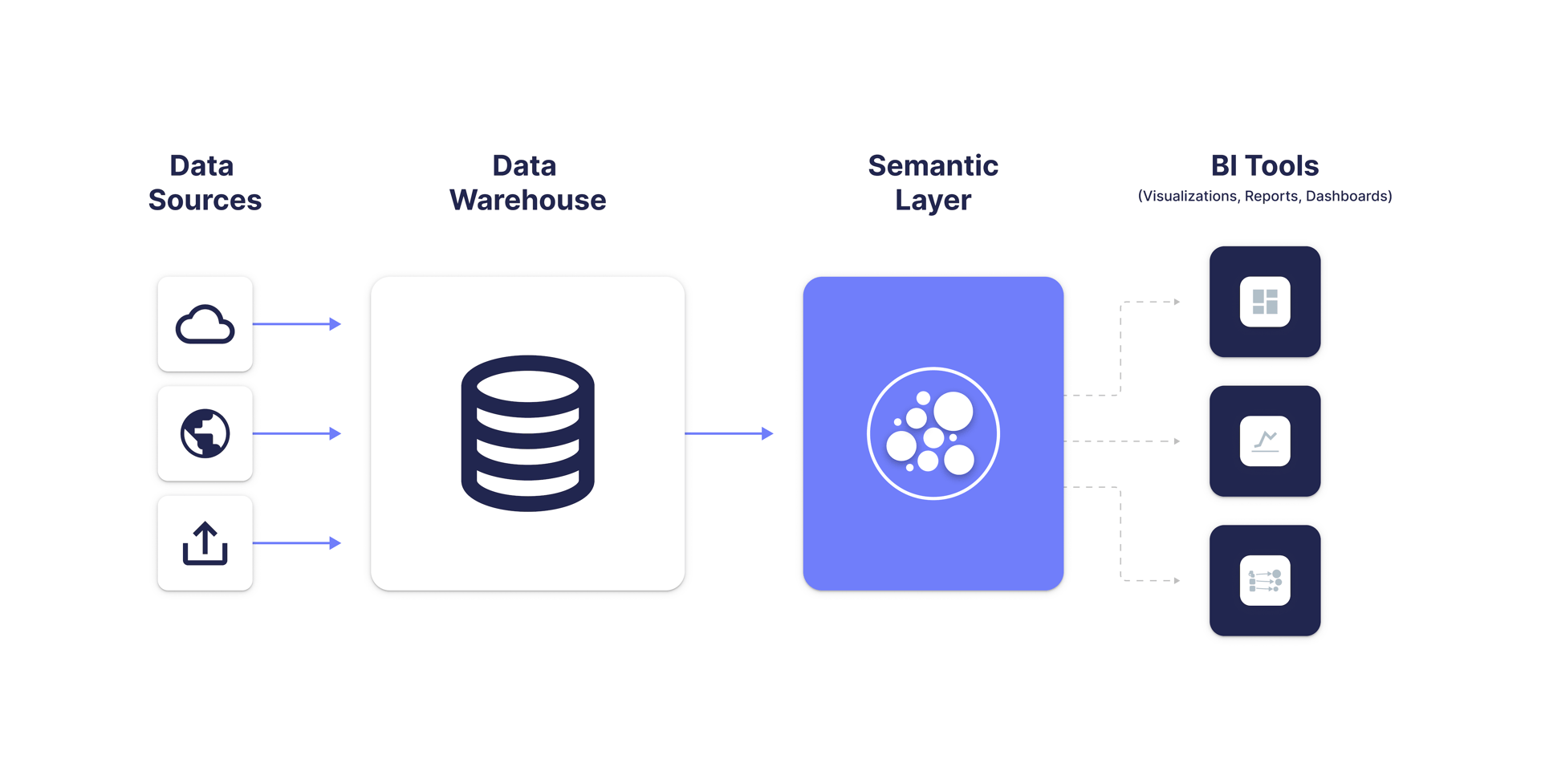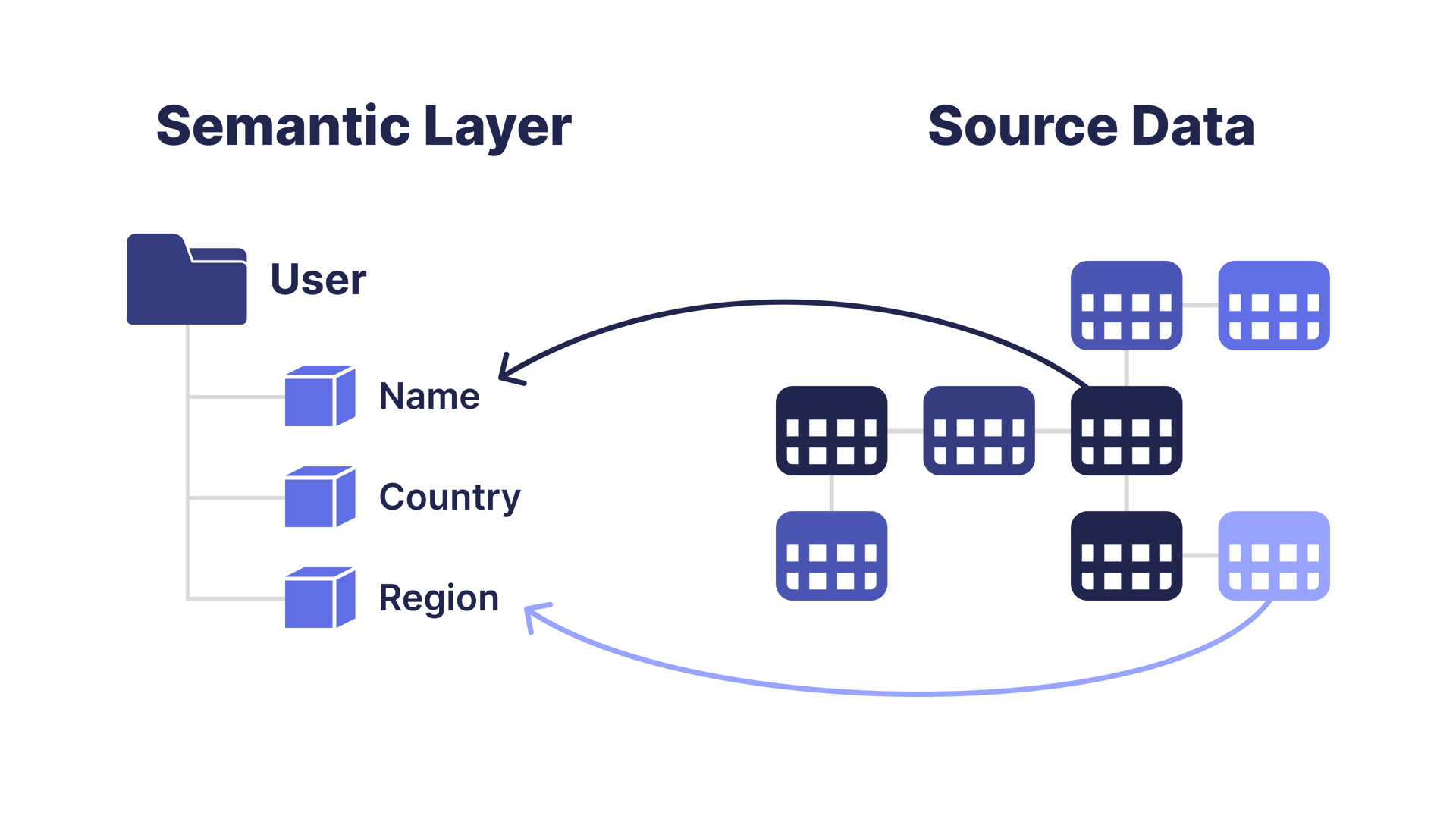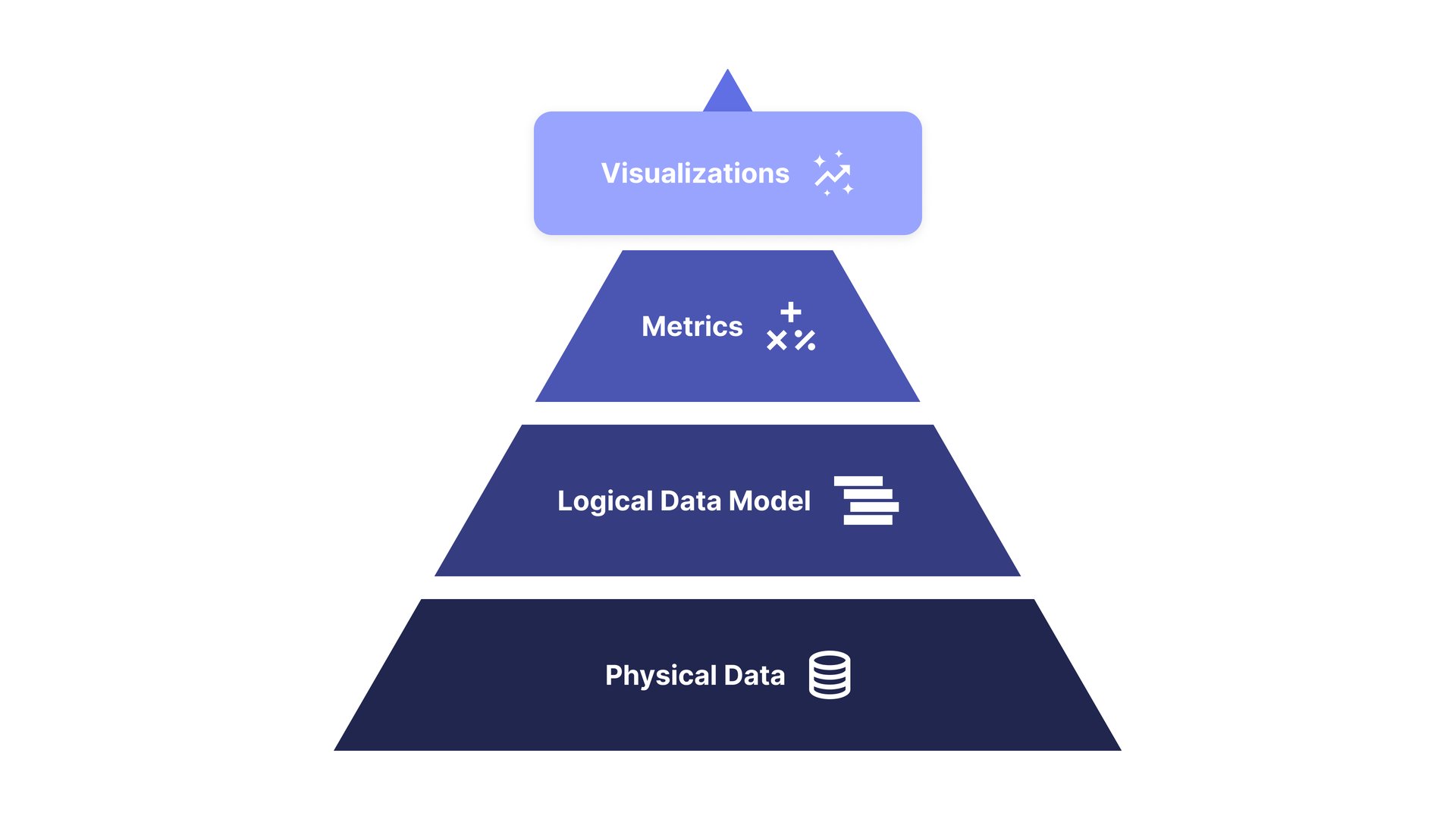How a semantic layer unlocks insights from data

The Power of Business Data
The potential of data within the business environment is tremendous. Each day, organizations generate vast volumes of data from diverse sources and in various formats. When harnessed effectively, this data can unlock valuable insights, drive innovation, optimize operational efficiency, and guide informed decision-making processes through meaningful metrics.
However, it's crucial to acknowledge that the majority of a company's workforce are individuals who aren't data engineers or analysts working directly with raw and complex data. As a result, it is important to make this wealth of information available in a manner that's understandable to the entire organization, offering a business-friendly view for all stakeholders.
Semantic Layers in Modern Business
A central concern in meeting these requisites involves the isolation of valuable data assets within data centers, which can be stored either locally or facilitated by cloud services. Collected data commonly lacks standardization, and business definitions remain disparate, posing challenges for organizations aiming to extract the utmost value from their data reserves. In the face of these challenges, a semantic layer emerges as a viable resolution as a part of a modern data stack.

Semantic layers simplify the task of managing extensive datasets and deriving real-time insights for a company by establishing a linkage between business information and data engineers. This connection serves to standardize and unify the definitions of business metrics, gaining consensus among business as well as data teams.
The established semantic bridge allows for successful collaboration among team members with diverse profiles and professional backgrounds. Whether an individual is an economist, a member of the HR team, a programmer, or even a law graduate, they can extract valuable insights through an analytical approach empowered through an efficient semantic layer.
Should I Consider Implementing a Semantic Layer?
Before we dive into the details of the semantic layer, it's important to figure out if your business really needs this technology. If your current landscape involves the utilization of multiple business intelligence tools, you might already be grappling with the challenges of processing and querying data from diverse sources. This complexity can easily culminate in a lack of trust among users regarding data accuracy and analytics, subsequently resulting in suboptimal decision-making processes.
Moreover, when the goal is to restrict data access to specific employees and ensure that relevant information reaches the appropriate staff members, the process of organizing data into suitable directories becomes even more complex.
Finally, for big companies processing lots of queries, slow query speeds can be a big problem, leading to difficulties in timely access to essential metrics. The consequence often manifests as sluggish responses, lags, and time delays - frustrating for users and consuming valuable time.
The Layer as a Solution
A semantic layer could serve as a solution for all the mentioned challenges. When implemented correctly, the semantic layer offers a unified interface for all query applications, fostering confidence in data quality while maintaining coherence and transparency in the outcomes generated. Access policies are carefully enforced, incorporating data security and governance through defined rules.
Data connections remain live, facilitating real-time query operations. The layer also takes charge of query performance by recognizing distinct query patterns for each user, thus optimizing the speed of query delivery.
Undoubtedly, the provided reasons are not the exclusive considerations warranting the incorporation of the semantic layer. Throughout the remainder of this article, we will delve into the fundamental components of this layer, explore its merits and drawbacks, and illustrate its relevance with prominent real-world use cases.
Demystifying the Concept
The term "semantic layer" is rooted in its utilization of semantics - comprising rules and query languages tailored to construct synthetic layer elements. The core concept behind the semantic layer is to establish a mapping between physical data structures to form conceptual data models.
This process culminates in the layer's principal function: to present collected data in a standardized and business-oriented manner. Functioning as an intermediary between databases and the consumption tools employed by end users, this layer delivers a simplified representation of data. It serves as the singular source of truth within a business environment, defining the rules and relationships that underpin data components and establishing a universally recognized data vocabulary.
It's important to note that the semantic layer itself doesn't store data; it just offers a representation of data. It houses information about data objects stored in data sources, which are utilized to generate queries for retrieving specific information.
For users, this layer speeds up data exploration and access through familiar business terms - purchase, revenue, customer, trend, metric, conversion, and more. This semantic approach empowers users to interact with hierarchically organized lists (see image below), departing from the traditional tabular view and complex relationships of raw data.

Layer Types
Customized for specific needs, semantic layers can take on various forms: they could manifest as a semantic layer within a data warehouse, integrated within a data pipeline, embedded in data analytics processes, or they might adopt a universal role. In the context of a data warehouse, semantic layers serve the purpose of extracting data segments into business intelligence tools, thereby presenting a unified source of truth for all organizational departments.
In the context of data pipelines, which orchestrate the convergence of data from various sources into a centralized repository, semantic layers come into play when organizing and naming data models, exemplified by tables. Data analytics also benefits from a semantic layer, as it helps present business-specific definitions, relationships, and concepts.
Additionally, it facilitates the formulation of metrics and execution of calculations, fueling responsive reporting and analysis at the request of end users. In contrast, a universal semantic layer expands its view, exceeding individual business requisites.
Designed to be versatile and comprehensive, its mission pivots on fostering organization-wide knowledge dissemination and information exchange.
How to Choose the Right Layer Type?
The choice of the right semantic layer type depends on various factors, including the desired outcomes from the analytics process, which may involve metrics and calculations. These encompass a broad spectrum of considerations, including the distinctive attributes of data sources, the diverse makeup of user demographics, the specific analytical tools that have been deployed, and the precise outcomes desired from the analytics process. The interaction of these factors shapes an optimal semantic layer setup, guaranteeing its seamless adaptation to the specific demands and objectives of the organization.
Properties
The fundamental elements of a semantic layer can be grouped into categories such as data sources, data models, business logic, and metadata. In terms of data, this layer establishes connections with various data sources - ranging from data lakes and data warehouses to conventional databases—housing the underlying raw data.
Subsequently, the task at hand necessitates determining how data from these sources is structured and transformed to yield a cohesive representation of information. For this purpose, data models come into play, primarily taking the form of physical and logical categories. A physical model encompasses the pre-existing design of a database, dictating attributes such as table structures, column names, data types, and more.
Conversely, a logical model sits above the physical model, defining the connections between attributes and data entities that originate from the physical data model. The layer allows for the smooth integration of data from various sources, tailored to meet each company's unique requirements.
One potential configuration of a semantic layer can be visually depicted, as shown below.

To provide precision and consistency to business definitions and organizational policies, business rules and relevant logic can be embedded within the semantic layer. Conclusively, metadata steps in to provide supplementary insights concerning the data while concurrently upholding security and governance measures.
Finally, metrics - in the form of numerical values - aggregate data that exists within the logical data model, offering a compact way to quantify and interpret the information encapsulated within.
Strategic Insights into Building a Semantic Layer
Constructing a new semantic layer entails a strategic approach, with each step contributing to its comprehensive functionality. To begin this process, focus should be placed on several key steps. It all starts by identifying vital business features within raw data and subsequently assigning suitable names to corresponding table columns.
As the foundation is laid, the next pivotal phase involves aggregating data from diverse tables and organizing them in a coherent and meaningful manner. This structured compilation forms the bedrock for the following phase—forging required connections among the data.
These connections come to life through the introduction of mathematical formulas skillfully applying business definitions and dependencies. With a seamless interplay of data, the semantic layer evolves into a platform where complex insights can be efficiently accessed and understood.
Ensuring Success
To ensure the efficacy of the semantic layer, continuous evolution is imperative. Regular updates must be facilitated, enabling adaptability in response to changing business landscapes. Rigorous testing conducted across various user profiles and real-world case studies aids in fine-tuning the layer's performance.
This iterative process not only refines its capabilities but also offers valuable insights into the adoption patterns of different analytical features. Moreover, the semantic layer's role as a source of truth mandates efficient monitoring to maintain up-to-date insights and robust governance. By consistently offering accurate and reliable data and metrics, the semantic layer empowers decision-makers with the confidence to derive meaningful conclusions.
In addition, to create a flexible and long-lasting solution, it's advisable for the semantic layer to remain vendor-agnostic. This approach ensures that the layer's applicability isn't limited to a specific product, providing a flexible environment that's adaptable to diverse technological landscapes.
Benefits
Unified Collaboration
Continuing from the previously observed benefits of implementing such a layer, we gain a comprehensive understanding of its advantages, further highlighting why it's a good choice. Moving beyond these evident benefits, the designed semantic layer takes on a pivotal role by fostering seamless collaboration among diverse teams within a unified environment. This arrangement not only promotes the consistent use of standardized business terminology but also harmonizes parallel efforts aimed at achieving main business goals.
Building on its strengths, the semantic layer extends its impact by facilitating granular-level access control and security, covering both group and individual user levels. Operating within this sophisticated security framework ensures data protection while granting authorized personnel necessary access.
Universal Data Understanding
A key strength of the semantic layer is its ability to make data easy to understand for everyone in the company. This accomplishment is achieved through the establishment of a shared language for interpreting data, converting data "messages" into insightful narratives that resonate throughout the entire organization.
Additionally, this layer significantly reduces the time between initiating a query and obtaining actionable insights. This acceleration empowers users to rapidly convert data inquiries, including metric-related queries, into actionable decisions, thereby catalyzing the agility of decision-making processes.
Simplified Metric Creation
Moreover, the layer's efficiency extends to the domain of metrics. The creation of metrics becomes a one-time endeavor, eliminating the need for repetitive recreation with each new application. This increased efficiency translates directly into enhanced performance. Through the virtual encapsulation of information, the semantic layer seamlessly integrates real-time responses into business systems.
Users are further empowered through grouping based on common attributes and preferences, resulting in personalized access and interactions that match individual needs.
Flexibility
The natural flexibility of each semantic layer is remarkable. Each layer can be duplicated and repurposed multiple times to create distinct domain-specific semantic layers. In this capacity, each layer serves as a repository for mathematical calculations and metric definitions, streamlining analytical processes.
Beyond serving as an interface, the semantic layer encompasses a suite of tools encompassing data cleaning, pre-processing, and transformation. This holistic data management approach strengthens data quality, leading to better precision and consistency in the insights derived.
Limitations
In addition to the many benefits a semantic layer can offer, there are also noteworthy potential shortcomings that deserve attention. Firstly, each business intelligence vendor has its proprietary semantic layer accompanied by its own query language, necessitating data engineers within a company to familiarize themselves with these nuances.
Moreover, even the most refined layers necessitate ongoing maintenance and synchronization with evolving changes, resulting in possible high expenses. In situations where a semantic layer operates with centralized business-oriented data sources, adapting to specific business domain needs can prove complex and challenging. When queries must be executed against comprehensive cloud-scale tables, response times for metric-related queries often lag, even for robust cloud engines.
One solution to this issue involves extracting data into an analytics platform for quicker queries and more convenient manipulation. However, this approach can lead to the emergence of additional challenges, such as semantic sprawl (employing multiple conflicting data definitions to describe one specific concept), as localized semantic layers are created to address specific needs.
Real-World Use Cases
A semantic layer serves as a vital tool across various industries, facilitating the consolidation of data from diverse sources. This streamlined data acts as a catalyst for data-driven decision-making, effectively addressing challenges related to speed, performance, and scalability.
Let's begin by examining retail companies that gather substantial data, especially at the transaction level. Deriving valuable insights from such complex data can prove to be a challenging task. This is where the semantic layer comes into play, providing structured information about products and sales points. Similarly, in the context of e-commerce, synthetic layers seamlessly transform raw data into increased revenue by connecting different data sources, allowing for strategic sales campaign planning and enhanced customer visibility.
The financial services sector encounters the obstacle of securing financial data, making it challenging to gain comprehensive process insights and access data from various sources with distinct access policies. Semantic layers offer a solution, empowering finance companies to make informed business decisions and effectively measure key financial metrics. This potential also extends to the insurance sector, where semantic layers aggregate data from various systems to provide insights into market trends, customer behavior, and risk assessment.
In healthcare, analysts leverage semantic layers to predict patient conditions, manage resource consumption, and ensure an adequate supply of medicines and medical equipment. In the travel industry, synthetic layers provide easy access to data, enabling the creation of forecasting tools and notifications about optimal prices, ultimately boosting sales volume.
The success stories involving semantic layers are abundant. Across various business landscapes generating substantial operational data, the semantic layer emerges as a key resource for organizing information and extracting invaluable insights from raw data.
A soon-to-be-obsolete technology?
Semantic layers are far from being a passing trend; they are firmly established as a lasting and evolving solution. Instead of fading into obscurity, they are continuously refined and upgraded to meet the evolving needs of organizations. In fact, businesses that embrace semantic processes are ready to outperform those that do not. Looking ahead, semantic layers' trajectory points towards vendor independence and cross-compatibility with diverse client tools.
Their overall design will prioritize universality, aiming to facilitate knowledge sharing and management across different sectors. Moreover, they are anticipated to seamlessly accommodate structured and unstructured data, diverse file formats, and even semantic graphical visualizations and the capability to measure various data metrics. The path forward also includes the desired capability for semi-manual and completely automatized approaches for building semantic models.
The Age of Language Models
Finally, it should be noted that in light of the significant advancements in Large Language Models and the widespread popularity they have garnered, the development and necessity of technologies like semantic layers are set to become more noticeable.
The potential of direct interactions with diverse language models and their associated engines has only begun to unfold, revealing the capacity for precise and timely information delivery.
As users become more accustomed to this seamless communication, their expectations will naturally rise, underscoring the demand for proficient query engines and efficient processors capable of handling extensive databases. Semantic layers are here to stay.